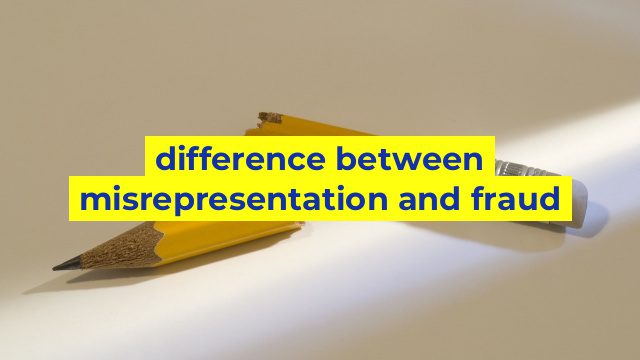Understanding the Difference Between Misrepresentation and Fraud
When it comes to legal matters, misrepresentation and fraud are two terms that are often used interchangeably. However, while they may seem similar, they have different meanings and consequences. This article will help you understand the difference between misrepresentation and fraud.
Misrepresentation
Misrepresentation is when one party makes false or misleading statements (or fails to disclose important facts) to another party in order to induce that party to enter into a contract. The key element of misrepresentation is that the false or misleading statement must have influenced the other party’s decision to enter into the contract. Essentially, the party making the false statement is leading the other party to believe something that is not true.
There are three types of misrepresentation:
– Innocent misrepresentation: When a false statement is made but the person making it had no reason to believe that it was untrue or misleading. In this case, the contract is voidable, and the innocent party can seek to have the contract set aside.
– Negligent misrepresentation: When a false statement is made recklessly, without any care or consideration for whether it is true or not. In this case, the contract is voidable, and the innocent party can seek compensation for any losses suffered as a result of the false statement.
– Fraudulent misrepresentation: When a false statement is made knowingly, with the intent to deceive the other party. In this case, the contract is voidable, and the innocent party can seek compensation for any losses suffered, as well as punitive damages.
Fraud
Fraud is similar to fraudulent misrepresentation, but it involves more than just false or misleading statements. To constitute fraud, there must be an intent to deceive or manipulate the other party. This can take many forms, such as:
– Concealing or withholding important information
– Making false promises or guarantees
– Providing false documentation
– Falsifying financial statements
The key difference between fraud and misrepresentation is the element of intent. Fraudsters have a deliberate intent to deceive, while misrepresentation can be accidental or negligent.
Fraud can have serious legal consequences, including fines, imprisonment, and civil liability. If you believe that you have been a victim of fraud, it is important to seek legal advice as soon as possible.
Conclusion
Understanding the difference between misrepresentation and fraud is important for anyone entering into a contract. Both can have serious consequences, but fraud carries a higher burden of proof and is more severe. By knowing the difference, you can better protect yourself and your interests.
Table difference between misrepresentation and fraud
| Types of Deception | Difference |
|---|---|
| Misrepresentation | Misrepresentation involves making false or misleading statements about a material fact with the intent to deceive someone. It can also occur if there is a failure to disclose important information that would change someone’s decision. |
| Fraud | Fraud, on the other hand, involves intentionally deceiving someone through false statements, actions or omissions. Fraud requires the intent to deceive and usually involves financial or legal consequences. It often entails making false representations with the knowledge that they are untrue, and with the intention of convincing someone to act in a certain way. |
